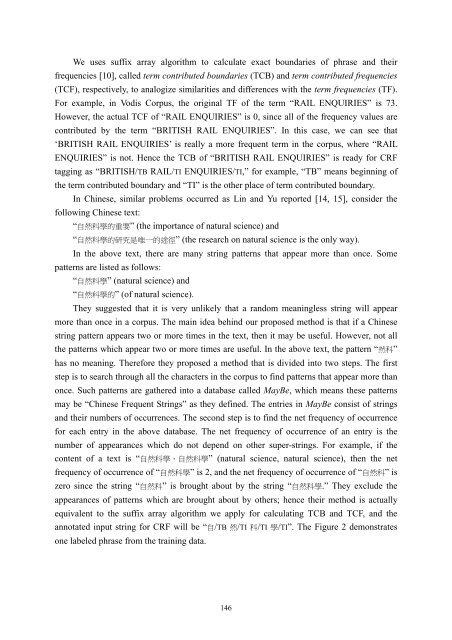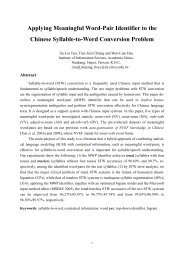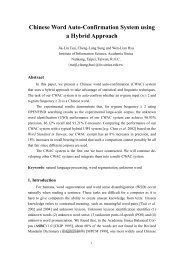Term Contributed Boundary Feature using ... - Academia Sinica
Term Contributed Boundary Feature using ... - Academia Sinica
Term Contributed Boundary Feature using ... - Academia Sinica
You also want an ePaper? Increase the reach of your titles
YUMPU automatically turns print PDFs into web optimized ePapers that Google loves.
We uses suffix array algorithm to calculate exact boundaries of phrase and their<br />
frequencies [10], called term contributed boundaries (TCB) and term contributed frequencies<br />
(TCF), respectively, to analogize similarities and differences with the term frequencies (TF).<br />
For example, in Vodis Corpus, the original TF of the term “RAIL ENQUIRIES” is 73.<br />
However, the actual TCF of “RAIL ENQUIRIES” is 0, since all of the frequency values are<br />
contributed by the term “BRITISH RAIL ENQUIRIES”. In this case, we can see that<br />
‘BRITISH RAIL ENQUIRIES’ is really a more frequent term in the corpus, where “RAIL<br />
ENQUIRIES” is not. Hence the TCB of “BRITISH RAIL ENQUIRIES” is ready for CRF<br />
tagging as “BRITISH/TB RAIL/TI ENQUIRIES/TI,” for example, “TB” means beginning of<br />
the term contributed boundary and “TI” is the other place of term contributed boundary.<br />
In Chinese, similar problems occurred as Lin and Yu reported [14, 15], consider the<br />
following Chinese text:<br />
“ 自 然 科 學 的 重 要 ” (the importance of natural science) and<br />
“ 自 然 科 學 的 研 究 是 唯 一 的 途 徑 ” (the research on natural science is the only way).<br />
In the above text, there are many string patterns that appear more than once. Some<br />
patterns are listed as follows:<br />
“ 自 然 科 學 ” (natural science) and<br />
“ 自 然 科 學 的 ” (of natural science).<br />
They suggested that it is very unlikely that a random meaningless string will appear<br />
more than once in a corpus. The main idea behind our proposed method is that if a Chinese<br />
string pattern appears two or more times in the text, then it may be useful. However, not all<br />
the patterns which appear two or more times are useful. In the above text, the pattern “ 然 科 ”<br />
has no meaning. Therefore they proposed a method that is divided into two steps. The first<br />
step is to search through all the characters in the corpus to find patterns that appear more than<br />
once. Such patterns are gathered into a database called MayBe, which means these patterns<br />
may be “Chinese Frequent Strings” as they defined. The entries in MayBe consist of strings<br />
and their numbers of occurrences. The second step is to find the net frequency of occurrence<br />
for each entry in the above database. The net frequency of occurrence of an entry is the<br />
number of appearances which do not depend on other super-strings. For example, if the<br />
content of a text is “ 自 然 科 學 , 自 然 科 學 ” (natural science, natural science), then the net<br />
frequency of occurrence of “ 自 然 科 學 ” is 2, and the net frequency of occurrence of “ 自 然 科 ” is<br />
zero since the string “ 自 然 科 ” is brought about by the string “ 自 然 科 學 .” They exclude the<br />
appearances of patterns which are brought about by others; hence their method is actually<br />
equivalent to the suffix array algorithm we apply for calculating TCB and TCF, and the<br />
annotated input string for CRF will be “ 自 /TB 然 /TI 科 /TI 學 /TI”. The Figure 2 demonstrates<br />
one labeled phrase from the training data.




